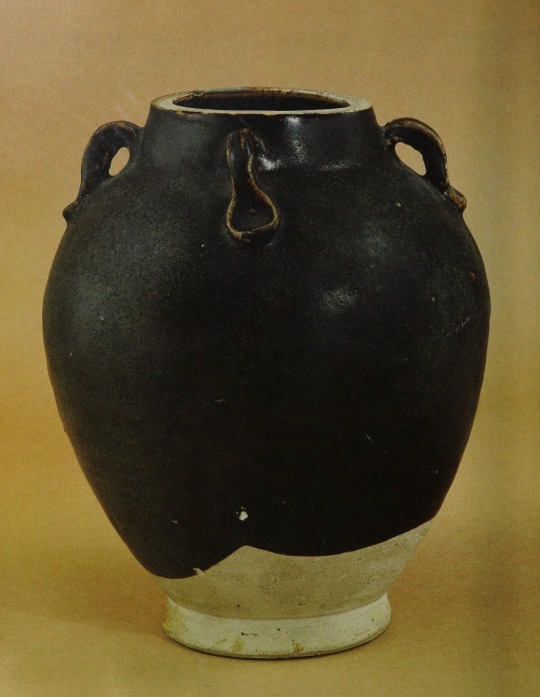#blackware
Explore tagged Tumblr posts
Text



Stirrup-spout bottles in the form of a duck and a puma, c. 1100-1400 CE
Chimú (Peru, North coast)
Ceramic (blackware pottery)
Smithsonian NMAI 23/6883, 23/190
#animals in art#birds in art#bird#duck#puma#feline#wild cat#Andean art#Peruvian art#Sourh American art#Indigenous art#Chimu art#Smithsonian NMAI#pottery#ceramics#blackware#animal effigy#effigy vessel#pair#museum visit
295 notes
·
View notes
Text

Carved Bowl with Olmec Dragon Motif
Olmec, Mexico, 1200-900 BCE (Early Pre-Classic)
The apparently simple, non-figurative design actually shows an abstracted image of a mythical creature known as the “Olmec dragon.” It combined features of different powerful predators of the region, including the harpy eagle, crocodile, and jaguar. The horizontal and vertical lines here show the fast-moving body and tufted eyebrows of this creature. The red pigment here is the mercury compound cinnabar, brought from sources hundreds of miles away.
40 notes
·
View notes
Photo

Blackware pot, 1930s, New Mexico.
20 notes
·
View notes
Text

He also voices birb (Aerobolt) in Transformers Robots in Disguise
the fact that tfp starscream and tfrb heatwave have the same voice actor is blowing my mind rn, someone send help


#looking through his voice list#and what do you mean he did Blackwar Greymon#I'm sorry he did the Drum demon from demon slayer bruh#gotta love when vas voice two characters that re polar opposites tho#lol
546 notes
·
View notes
Text


vase
Cultures/periods: Moche
Findspot: Trujillo (Peru)
Provenience unknown, possibly looted
Vase (stirrup spout; with scene) made of pottery. Blackware. Fanged figure with an animal (snake?) headdress holding a doubled headed serpent, next to fish figure which is also holding the serpent.
British Museum
67 notes
·
View notes
Text

Single Spout Blackware Vessel in the Form of a Duck. Chimú. Peru. 1000-1400 CE.
Art Institute of Chicago.
#art#culture#history#sculpture#medieval history#medieval#Middle Ages#birds#bird#duck#ducks#animals in art#the art institute of chicago#native history#indigenous art#south american history#peruvian history#Peru#peruvian
9 notes
·
View notes
Text

“Black glazed jar, Tang dynasty, north China. The dull black glaze and the light-firing stoneware body are typical of ordinary northern blackwares from this period. H. 8 in., 20.3 cm. Ashmolean Museum, Oxford”
From: “Chinese glazes: their origins, chemistry and re-creation” by Wood Nigel; 2007.
17 notes
·
View notes
Text
About SEA DRAGON’S GIFT :
Part 43 of 83, A World of Sea tale

@mordenheim READ, LIKED and
REBLOGGED
SEA DRAGON’S GIFT : Part 43 of 83 ,
A World of Sea tale to
@nevermord who commented :

Doctor Woran's response to Kurin's question is based in my own personal experience. I have a few touchy points that date back at least sixty years!
About that parchment process; it dates back to the original refit of the Sun's Daughter to become the Dark Dragon. Mikal was given a shop to begin making the Blackware that became so universally used and popular all over the ship.
All sorts of fish hides were being boiled to release the fibers. As the hides broke down, there were actually two products, though one was only found by accident. The goal was the pliable mass of fibers that could be mixed with blacktangle glue to make the basic material of Blackware. The water the hides were boiled in became thickened by a mix of collagen and very micro fibers.
Some got spilled on a bench and dried in a thin sheet. A journeyman wrote "Clean this up" on it with brush and ink. The apprentice peeled the sheet off of the desk and was about to toss it into the melt pot when Mikal saw it. Thanks to its microfiberous content, the sheet had taken the ink without bleeding out.
Some powdered lime from heat reduced coral was added as an experiment to make it more opaque and the resulting sheet, after bleaching became the brilliant white parchment.
Master Stimms was called in to look over the basic process and he developed the equipment needed to produce the parchment in paper thin sheets taken up in rolls of uniform width. The resulting parchment, due to the fibers in it, is quite tough and resistant to simple tearing, though it cuts cleanly and can, as a result, be made into reams of exactly uniform sized sheets.
Blacktangle glue added to the initial mix will produce a black stout but flexible material that can be used to make backs for bound books and with a different formulation and thickness, stiff covers that can be tooled or embossed.
4 notes
·
View notes
Text
#pinponygirl #lifelongvictims #mind #russische_methode #errors_and_allin_intent #them_and_civillians #ch ain_of_command #outsourced_babycare #lawyerspin_and_ai #one_trick_of_many_germanconfirmerd #is #crim inal_governance #and #misguided #govt_caused_game_in_their_hierarchies #dip_immunity .@law @law @harvard_law @bbc_whys .@law @harvard_law .@bbcr4sundays .@scotu s @scotus @scotusblog @all @world @bbc_whys #how #toddler_vibe_dothe_right_thing_verify #trace #absolution?! #slike #public_law #germandeserve # sowhat #shouldhave #and #longtermeffects #axe_and_spoiler #quell #extraordinarily_viciously #right_thing_t o_do #unknown #actionability #themother #some_actually_believe_them #early #outsourced_babycare #you_can _verify_verdicts_along_ambiguity_and_what_judges_typically_aimed_for_here #targettedindividual #typicall y #mapped_crimes #witnessprotect #mind_who_is_victim #mind_who_is_expended #by_who_why #obliged_to _make_safety #rule #outsourced_babycare #defend_the_baby #magic _cola_to_have_sssexxx #accountable howmany #decoys #assumed #achmenno #vogelfrei #germanconfirmed #crimina lsecuritypolicy #howlong #romulan #rightsto #lawn?!? #lawn_or_law #disgusting_hopeless_victim #counterfa ctually_false #them_play_the_victim #expends_who_believed_em #obliged #bespucken #since_when #simply #fraudsystem #genuerbergti #dismal #lustgain_how #match #now_if_you_cou ld_finally_imminently_therefore_the... #basics #of #criminalsecuritypolicy #ugh #alibis #no _intel_overwatch ? #shows_s_not_them #simply #one_facette_of_criminal_securitypolicy #gitmo_mom _vs_president #expended #cases_where_judges_were_obliged_to_first_hunt_down_all_the_excesses_inthefirstplace_to_even_ma ke_it_s_e_e_m_dueprocess #obliged_to_firstly_avert_continuation_of_crimes #which_scums_did_not_u nderstand_and_cut_down_judges_as_too_victim_biased #it_is_gerrmany savelives mercy always moreprevention serotolerance with the fact s makesuremy alltimeframe support isok as thismess was criminalgove rnance criminal securitypolicy early on from intelbotch to all in harm targetted individual to down to blackwars and how states hi t eachothers balls and pets and that is the truth ///// pardoning and mercy doesnot make anyone less guilty they spare the asskick or some of the asskicks w e l l d e s e r v e d ///// dirty tools that endanger biology and life bet their ass would complain they cannotever again harm anyone else with cut down licen ses would be aeh aeh aeh crazyness as itwouldbe only a gambling try t o them shitheads wherewould labelpegging have kicked your ass in this intel shit //// what clowns get is "im a pink pony girl mamawhathaveyoudone" compromising lyrics rebabbled as zombi on experiment drug s damage effects which aspect of that would you quest //// with abit luck they barely f a k e safety onagain offagain to imp ly nothingtosee here before what and after what all along the timeline eventually not this time ///// clowns focus on framing shitballs instead of what did they do tothatguy everyday forhowlong themother even w a s i n t e l on it changes e v e r y t h i n g letalone illintent intel targetted individual the difference is that one two three oftheir methods top3 displaces whatthey did whatthey overtape todate with psychiatrisation criminalisation sssexxxsleaze anything is framed symptoms is framed your criminality is framed your aeh prostituteness youcan verify ifyouare fools by what you classify handle while th e p e r f o r m a n c e is what they ruinlives and or try dirty chains it is a timeless blackbox of dirty magic notmore notless atwhich path wouldyouhave derailed onthe shit they effort allalon g ////
#pinponygirl #lifelongvictims #mind #russische_methode #errors_and_allin_intent #them_and_civillians #chain_of_command #outsourced_babycare #lawyerspin_and_ai #one_trick_of_many_germanconfirmerd #is #criminal_governance #and #misguided #govt_caused_game_in_their_hierarchies #dip_immunity .@law @law @harvard_law @bbc_whys .@law @harvard_law .@bbcr4sundays .@scotus @scotus @scotusblog @all @world…
0 notes
Text
MYSTIC CIRCLE Release New Video for 'The Mothman' + Announce New Edition of “Kriegsgötter MMXXV”
MYSTIC CIRCLE have been busy as usual over the past few months and are currently in the middle of recording the follow-up album to “Erzdämon”, which will be called “Hexenbrand 1486“ and is due to see the light of day on October 31st, just in time for Halloween. In the meantime, the two horror maniacs and founding members Beelzebub and A. Blackwar have shot a video clip for “The Mothman”, an epic…
0 notes
Link
Check out this listing I just added to my Poshmark closet: Vintage Native Mexican/American Olla - Signed Blanca Corona R.
1 note
·
View note
Text
Happy #InternationalDayOfTheSeal ! 🦭


Sea Lion Effigy Stirrup Vessel
Moche, Peru, 50-800 CE (Early Intermediate-Middle Horizon)
Earthenware (Blackware), H: 6 1/4 x W: 9 1/2 x D: 6 1/4 in. (15.9 x 24.1 x 15.9 cm)
The Walters Art Museum 48.2842 https://art.thewalters.org/detail/79387/seal-effigy-stirrup-vessel/
“This vessel shows a swimming sea lion, an animal commonly found on islands in the Pacific Ocean close to Peru. Apart from being an important source of food for Andean people, sea lions commonly swallow beach pebbles, which they later vomit up. These stones were considered to have powerful medicinal qualities, and could be ground to make herbal remedies in ancient Peru.”
🆔 South American Sea Lion (Otaria byronia)
#animals in art#animal holiday#ancient art#Moche art#Peruvian art#South American art#Indigenous art#ceramics#blackware#effigy#stirrup vessel#seal sea lion#Walters Art Museum#International Day of the Seal#species ID
202 notes
·
View notes
Text

Blackware Bowl
Olmec
12th–8th century BCE
1 note
·
View note
Text
So yesterday I didn't go to locals cause my brother wasn't feeling well and it was my sister's birthday. Instead, what I'm going to be talking about is this very funny thing I saw in a discord server. It was blueflare mixed with blackwar, and I liked the idea, so I tried to recreate it, but the problem was it was very bricky because the level sixes could only digimon on black and red. It was only running the metalgrey x that digivolves for 1 from metalgreymon, so I tried to adjust it, but it always felt like too much of a brick to have anything other than the metalgretmon xros in hand and even then it felt more like a worse version of old blueflare. It gave me ideas, though, so instead, I changed it to the black and red wargreymon with a mix of the red metalgrey x and a few other things and I can't wait to test it!
0 notes
Link
Check out this listing I just added to my Poshmark closet: VTG Southwest Art by Lawrence Vargas Blackware Pottery Natural Turquoise Accents.
0 notes
Text

vase
Cultures/periods: Moche
Findspot: Trujillo (Peru)
Provenience unknown, possibly looted
Vase (stirrup spout) made of pottery. Blackware, in a cube shape with a stalk-like bird on each face.
British Museum
72 notes
·
View notes